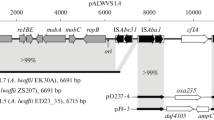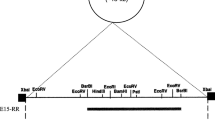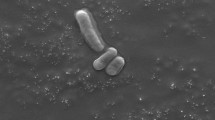Abstract
A cryptic 2.85 kb plasmid (pBf1) was isolated from the rumen bacteriumButyrivibrio fibrisolvens strain AR10, ampped with restriction endonucleases, and cleavage sites suitable for attachment toEscherichia coli plasmids were identified. AR10 was not able to be cured of pBf1 by growth at 42°C or in 0.25 μg ampicillin/ml, but growth in 50 μg acridine orange/ml for three culture passages produced cured colonies at a frequency of <1%. Chimeric plasmids were constructed by combining pBf1 with theE. coli plasmid pUC18, in addition to the clindamycin resistance gene fromBacteroides fragilis plasmid pDP1 (pCW2 and pCW3), or the CAT gene fromE. coli plasmid pKK232-8 (pCK1). For plasmid construction, pBf1 was cleaved at two alternative restriction sites to increase the likelihood that replication control sequences would remain functional in at least one of the plasmids. Electroporation of AR10 yielded transformant populations that clearly maintained the plasmids and that appeared to express the ampicillinase gene of pUC18, although transformants were not readily selectable with any of the three antibiotics. The suitability of pBf1 as a replicon on which to base the construction of shuttle vectors was demonstrated clearly, by persistence of plasmid pCW3 in the absence of selective pressure, and the addition of appropriate selection factors is expected to yield practical transformation vectors.
Similar content being viewed by others
Literature Cited
Brosius J (1984) Plasmid vectors for the selection of promoters. Gene 27:151–160
Dower WJ, Miller JF, Ragsdale CW (1988) High efficiency transformation ofE. coli by high voltage electroporation. Nucleic Acids Res 16:6127–6145
Gregg K, Sharpe H (1991) Enhancement of rumen microbial detoxification by gene transfer. In: Tsuda T, Sasaki Y, Kawashima R (eds) Physiological aspects of digestion and metabolism in ruminants. San Diego: Academic Press, pp 719–735
Gregg K, Bauchop T, Hudman JF, Vercoe P, Ware CE, Woods JR, Leng RA (1987) Application of recombinant DNA methods to rumen bacteria. In: Farrell DJ (ed) Recent advances in animal nutrition in Australia. University of New England, pp 112–120
Hanahan D (1985) Techniques for transformation ofE. coli. In: Glover DM (ed) DNA cloning: a practical approach, Vol 1. Oxford: IRL Press, pp 109–135
Hazlewood GP, Gilbert HJ (1989) Genetic engineering and ruminant digestion. Proc Royal Ag Soc (England) Monograph Series No 9, pp 79–86
Hespell RB (1985) Potential for manipulation of ruminal bacteria using recombinant DNA technology. In: Leng RA, Barker JSF, Adams DB, Hutchinson KJ (eds) Biotechnology and recombinant DNA technology in the animal production industries-Rev Rural Sci 6. University of New England, pp 95–100
Hudman JF, Gregg K (1989) Genetic diversity among strains of bacteria from the rumen. Curr Microbiol 19:313–318
Klieve AV, Hudman JF, Bauchop T (1989) Inducible bacteriophages from ruminal bacteria. Appl Environ Microbiol 55:1630–1634
Maniatis T, Fritsch EF, Sambrook J (1982) Molecular cloning: a laboratory manual. Cold Spring Harbor, New York: Cold Spring Harbor Laboratory Press
Matthews BG, Guiney DG (1986) Characterization and mapping of regions encoding clindamycin resistance, tetracycline resistance, and a replication function on theBacteroides R plasmid pCP1. J Bacteriol 167:517–521
Raleigh EA, Murray NE, Revel H, Blumenthal RM, Westaway AD, Rigby PWJ, Elhai J, Hanahan D (1988) McrA, McrB restriction phenotypes of someE. coli strains and implications for gene cloning. Nucleic Acids Res 16:1563–1575
Russell JB, Wilson DB (1988) Potential opportunities and problems for genetically altered rumen micro-organisms. J Nutr 118:271–279
Southern E (1975) Detection of specific sequences among DNA fragments separated by gel electrophoresis. J Mol Biol 98:503–517
Teather RM (1985) Application of gene manipulation to rumen microflora. Can J Anim Sci 65:563–574
Thomson AM, Flint HJ (1989) Electroporation induced transformation ofBacteroides ruminicola andBacteroides uniformis by plasmid DNA. FEMS Microbiol Lett 61:101–104
Author information
Authors and Affiliations
Rights and permissions
About this article
Cite this article
Ware, C.E., Bauchop, T., Hudman, J.F. et al. Cryptic plasmid pBf1 fromButyrivibrio fibrisolvens AR10: Its use as a replicon for recombinant plasmids. Current Microbiology 24, 193–197 (1992). https://doi.org/10.1007/BF01579281
Issue Date:
DOI: https://doi.org/10.1007/BF01579281




